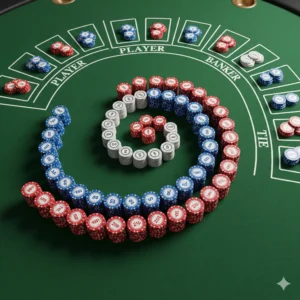
The Fibonacci strategy is a more conservative negative progression betting system based on the famous Fibonacci sequence (1, 1, 2, 3, 5, 8…). After a loss, you move to the next number in the sequence for your next bet size. After a win, you move back two numbers in the sequence. It is less aggressive than the Martingale system, as your bets don’t escalate as quickly, making it easier to manage a losing streak without devastating your bankroll.
What is the Fibonacci Sequence?
Before applying it to Baccarat, it’s essential to understand the sequence itself. The Fibonacci sequence is one of the most famous formulas in mathematics, where each number is the sum of the two preceding ones.
It starts with 1 (or 0) and progresses as follows: 1, 1, 2, 3, 5, 8, 13, 21, 34, 55, 89… (1+1=2, 1+2=3, 2+3=5, and so on)
Named after the Italian mathematician Leonardo of Pisa, this sequence appears throughout nature, from the spirals of a seashell to the branching of trees. It is this connection to a perceived “natural order” that has made it an alluring, if flawed, tool for gamblers.
How to Use the Fibonacci Strategy in Baccarat: Step-by-Step
The Fibonacci strategy is a negative progression system, meaning you increase your stake after a loss. However, its progression is far gentler than the Martingale’s exponential doubling.
The Progression (After a Loss)
You start by betting one unit. If you lose, your next bet is the next number in the Fibonacci sequence. You continue moving forward along the sequence with each consecutive loss.
The Regression (After a Win)
This is the key rule: when you win a bet, you move back two steps in the sequence. Your next bet is the number two positions prior. The goal is to get back to the very beginning of the sequence (betting 1 unit). If you succeed, you will have recovered your previous losses and locked in a profit.
A Practical Example
Let’s walk through a sequence with a $10 base unit:
Bet $10 (1 unit) and lose. (Sequence: 1)
Bet $10 (1 unit) and lose. (Sequence: 1, 1)
Bet $20 (2 units) and lose. (Sequence: 1, 1, 2)
Bet $30 (3 units) and lose. (Sequence: 1, 1, 2, 3)
Bet $50 (5 units) and WIN. You win $50. Now, you move back two steps in the sequence (from 5 to 2).
Bet $20 (2 units) and WIN. You win $20. Move back two steps (from 2 to the start).
You are now back at the beginning of the sequence. Let’s calculate the result:
Losses: $10 + $10 + $20 + $30 = $70
Wins: $50 + $20 = $70
Result: You are back to even. You would then restart with a $10 bet.
Analyzing the Risk and Reward
The Fibonacci system presents a unique balance of risk and reward, sitting comfortably between the safety of flat betting and the extreme danger of the Martingale.
The Advantages: Why It’s Safer than Martingale
The primary advantage of the Fibonacci system is its slow, arithmetic progression compared to the Martingale’s exponential growth. After 7 losses, a Martingale bettor would need to wager 128 units, while a Fibonacci bettor only needs to wager 21 units. This makes the system far more resilient to long losing streaks and less likely to hit table limits quickly, thus better protecting your bankroll.
The Disadvantages: The Inescapable Flaws
Despite its more conservative nature, the Fibonacci system is not a magic bullet.
It Can Still Be Costly: While slower, a prolonged losing streak will still require a significant bet size and can deplete a bankroll.
Recovery is Slow: Unlike the Martingale, a single win does not recover all previous losses. As seen in our example, it can take multiple subsequent wins to get back to even after a losing streak.
The House Edge is Unbeatable: The Fibonacci strategy, like all others, is simply a way of structuring your wagers. It has no effect on the outcome of the cards. The house edge remains constant on every hand, and no betting system can overcome this fundamental mathematical reality.
Our Unique Viewpoint: The Allure of Mathematical Mysticism
Beyond the numbers, the enduring appeal of the Fibonacci strategy lies in what we call “mathematical mysticism.” The Fibonacci sequence is a profound and beautiful pattern found throughout the natural world. By applying this “golden ratio” to a game of chance, players feel they are doing more than just gambling—they feel they are tapping into a hidden, universal order.
This provides a powerful illusion of sophisticated control. The act of using a famous mathematical sequence feels more intelligent and deliberate than simply guessing. It is a psychological comfort mechanism, allowing players to impose an elegant, historical, and seemingly “natural” pattern onto a chaotic, random process. The allure of the Fibonacci strategy, therefore, is less about its actual efficacy and more about the psychological satisfaction of feeling like you have a deeply ordered system in a disordered environment.
Conclusion: An Interesting System with Familiar Flaws
The Fibonacci strategy is a fascinating and intellectually stimulating approach to Baccarat betting. It offers a much safer and more manageable negative progression than the high-stakes Martingale system. However, despite its elegant origins in the natural world, it remains a betting system subject to the same inescapable laws of mathematics and probability. It cannot eliminate the house edge. For players who enjoy a structured, mathematical approach and understand its limitations, the Fibonacci system can be an engaging way to manage a session, but it should never be mistaken for a guaranteed path to profit.
